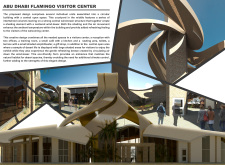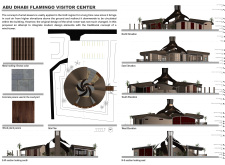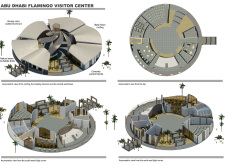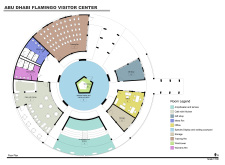5 key facts about this project
The Abu Dhabi Flamingo Visitor Center stands out as a well-considered addition to the landscape of the UAE. Built in a circular shape around a central open courtyard, the facility serves as a place for education and leisure. The design emphasizes traditional elements, particularly the wind-tower, which plays a crucial role in cooling the interior spaces and enhancing visitor comfort.
Architectural Concept
The circular organization of the building promotes a flow of movement and interaction among visitors. The open courtyard is framed by intertwined columns that guide the eye toward the central wind-tower. This feature not only serves as a visual focal point but also as a functional element, helping to ventilate the building naturally. The design provides shaded areas throughout, making it easier for people to enjoy the outdoors while avoiding direct sunlight.
Spatial Organization
The layout includes various essential spaces to support the center's functions. Facilities within the structure comprise a reception area, a training room, a café with kitchen capabilities, restrooms, and a terrace with a shaded amphitheater. Each area is carefully planned to promote a rich experience for visitors, allowing them to engage in learning while exploring the natural environment. The central space highlights aspects of desert life, with shaded sections that encourage visitors to pause and take in their surroundings.
Materiality
The materials used in the construction are selected to enhance both appearance and functionality. The metal roofing is finished in bronze, offering durability and a visual connection to the landscape. The courtyard features concrete pavers, ensuring a solid walking surface, while wood plank pavers add a natural feel that integrates the structure into its surroundings effectively.
Design Details
Sustainability is a key focus of the visitor center's design, minimizing the need for mechanical cooling systems. The thoughtful incorporation of passive cooling techniques reflects traditional practices that make the interior comfortable. As visitors explore, they will find large shaded areas designed for relaxation and observation of the unique desert ecosystem, fostering a deeper connection to the environment around them.





















































